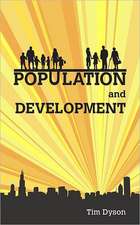Causal Analysis in Population Studies: Concepts, Methods, Applications: The Springer Series on Demographic Methods and Population Analysis, cartea 23
Editat de Henriette Engelhardt, Hans-Peter Kohler, Alexia Fürnkranz-Prskawetzen Limba Engleză Hardback – 8 mai 2009
In population studies, most research is based on non-experimental designs (observational or survey designs) and rarely on quasi experiments or natural experiments. Using non-experimental designs to infer causal relationships—i.e. relationships that can ultimately inform policies or interventions—is a complex undertaking. Specifically, treatment effects can be inferred from non-experimental data with a counterfactual approach. In this counterfactual perspective, causal effects are defined as the difference between the potential outcome irrespective of whether or not an individual had received a certain treatment (or experienced a certain cause). The counterfactual approach to estimate effects of causes from quasi-experimental data or from observational studies was first proposed by Rubin in 1974 and further developed by James Heckman and others.
This book presents both theoretical contributions and empirical applications of the counterfactual approach to causal inference.
| Toate formatele și edițiile | Preț | Express |
|---|---|---|
| Paperback (1) | 638.57 lei 6-8 săpt. | |
| SPRINGER NETHERLANDS – 28 oct 2010 | 638.57 lei 6-8 săpt. | |
| Hardback (1) | 644.82 lei 6-8 săpt. | |
| SPRINGER NETHERLANDS – 8 mai 2009 | 644.82 lei 6-8 săpt. |
Din seria The Springer Series on Demographic Methods and Population Analysis
- 18%
 Preț: 951.14 lei
Preț: 951.14 lei - 15%
 Preț: 643.99 lei
Preț: 643.99 lei - 15%
 Preț: 643.16 lei
Preț: 643.16 lei - 18%
 Preț: 955.56 lei
Preț: 955.56 lei - 18%
 Preț: 952.40 lei
Preț: 952.40 lei -
 Preț: 393.90 lei
Preț: 393.90 lei -
 Preț: 393.74 lei
Preț: 393.74 lei - 15%
 Preț: 639.08 lei
Preț: 639.08 lei - 18%
 Preț: 952.89 lei
Preț: 952.89 lei - 18%
 Preț: 1118.45 lei
Preț: 1118.45 lei -
 Preț: 402.17 lei
Preț: 402.17 lei - 18%
 Preț: 953.82 lei
Preț: 953.82 lei - 15%
 Preț: 644.30 lei
Preț: 644.30 lei - 15%
 Preț: 663.93 lei
Preț: 663.93 lei - 18%
 Preț: 1380.95 lei
Preț: 1380.95 lei - 18%
 Preț: 953.65 lei
Preț: 953.65 lei - 18%
 Preț: 949.42 lei
Preț: 949.42 lei - 15%
 Preț: 644.82 lei
Preț: 644.82 lei - 18%
 Preț: 953.03 lei
Preț: 953.03 lei - 18%
 Preț: 952.09 lei
Preț: 952.09 lei - 15%
 Preț: 643.65 lei
Preț: 643.65 lei - 15%
 Preț: 643.99 lei
Preț: 643.99 lei - 15%
 Preț: 642.51 lei
Preț: 642.51 lei - 15%
 Preț: 644.95 lei
Preț: 644.95 lei - 15%
 Preț: 635.62 lei
Preț: 635.62 lei
Preț: 644.82 lei
Preț vechi: 758.60 lei
-15% Nou
Puncte Express: 967
Preț estimativ în valută:
123.39€ • 131.94$ • 102.88£
123.39€ • 131.94$ • 102.88£
Carte tipărită la comandă
Livrare economică 17 aprilie-01 mai
Preluare comenzi: 021 569.72.76
Specificații
ISBN-13: 9781402099663
ISBN-10: 1402099665
Pagini: 260
Ilustrații: VIII, 252 p.
Dimensiuni: 155 x 235 x 27 mm
Greutate: 0.54 kg
Ediția:2009
Editura: SPRINGER NETHERLANDS
Colecția Springer
Seria The Springer Series on Demographic Methods and Population Analysis
Locul publicării:Dordrecht, Netherlands
ISBN-10: 1402099665
Pagini: 260
Ilustrații: VIII, 252 p.
Dimensiuni: 155 x 235 x 27 mm
Greutate: 0.54 kg
Ediția:2009
Editura: SPRINGER NETHERLANDS
Colecția Springer
Seria The Springer Series on Demographic Methods and Population Analysis
Locul publicării:Dordrecht, Netherlands
Public țintă
ResearchCuprins
Causal Analysis in Population Studies.- Issues in the Estimation of Causal Effects in Population Research, with an Application to the Effects of Teenage Childbearing.- Sequential Potential Outcome Models to Analyze the Effects of Fertility on Labor Market Outcomes.- Structural Modelling, Exogeneity, and Causality.- Causation as a Generative Process. The Elaboration of an Idea for the Social Sciences and an Application to an Analysis of an Interdependent Dynamic Social System.- Instrumental Variable Estimation for Duration Data.- Female Labour Participation with Concurrent Demographic Processes: An Estimation for Italy.- New Estimates on the Effect of Parental Separation on Child Health.- Assessing the Causal Effect of Childbearing on Household Income in Albania.- Causation and Its Discontents.
Recenzii
From the reviews:
“This book contains a selection of nine of the contributions to a conference with the same title as the book, held in Vienna in December 2006. … The editors should be complimented for providing a clear focus on the econometric analysis of aspects of demographic behavior by issuing all these papers in a single volume. … Their appearance in a single volume will hopefully inspire more interest in economic demography among economists and more interest in econometric issues among demographers.” (Jan M. Hoem, European Journal of Population, Vol. 26, October, 2010)
“This book contains a selection of nine of the contributions to a conference with the same title as the book, held in Vienna in December 2006. … The editors should be complimented for providing a clear focus on the econometric analysis of aspects of demographic behavior by issuing all these papers in a single volume. … Their appearance in a single volume will hopefully inspire more interest in economic demography among economists and more interest in econometric issues among demographers.” (Jan M. Hoem, European Journal of Population, Vol. 26, October, 2010)
Textul de pe ultima copertă
The central aim of many studies in population research and demography is to explain cause-effect relationships among variables or events. For decades, population scientists have concentrated their efforts on estimating the ‘causes of effects’ by applying standard cross-sectional and dynamic regression techniques, with regression coefficients routinely being understood as estimates of causal effects. The standard approach to infer the ‘effects of causes’ in natural sciences and in psychology is to conduct randomized experiments. In population studies, experimental designs are generally infeasible.
In population studies, most research is based on non-experimental designs (observational or survey designs) and rarely on quasi experiments or natural experiments. Using non-experimental designs to infer causal relationships—i.e. relationships that can ultimately inform policies or interventions—is a complex undertaking. Specifically, treatment effects can be inferred from non-experimental data with a counterfactual approach. In this counterfactual perspective, causal effects are defined as the difference between the potential outcome irrespective of whether or not an individual had received a certain treatment (or experienced a certain cause). The counterfactual approach to estimate effects of causes from quasi-experimental data or from observational studies was first proposed by Rubin in 1974 and further developed by James Heckman and others.
This book presents both theoretical contributions and empirical applications of the counterfactual approach to causal inference.
In population studies, most research is based on non-experimental designs (observational or survey designs) and rarely on quasi experiments or natural experiments. Using non-experimental designs to infer causal relationships—i.e. relationships that can ultimately inform policies or interventions—is a complex undertaking. Specifically, treatment effects can be inferred from non-experimental data with a counterfactual approach. In this counterfactual perspective, causal effects are defined as the difference between the potential outcome irrespective of whether or not an individual had received a certain treatment (or experienced a certain cause). The counterfactual approach to estimate effects of causes from quasi-experimental data or from observational studies was first proposed by Rubin in 1974 and further developed by James Heckman and others.
This book presents both theoretical contributions and empirical applications of the counterfactual approach to causal inference.
Caracteristici
Estimation of causal relationships based on non-experimental data in population studies Comprehensive discussion of available techniques Contributions by the leading scholars in the field













